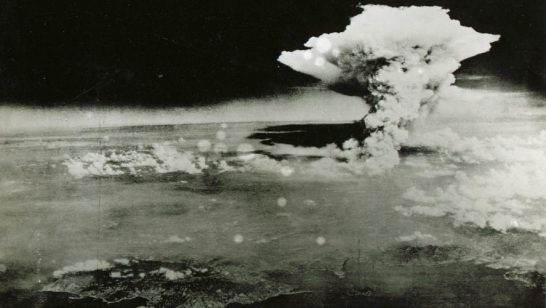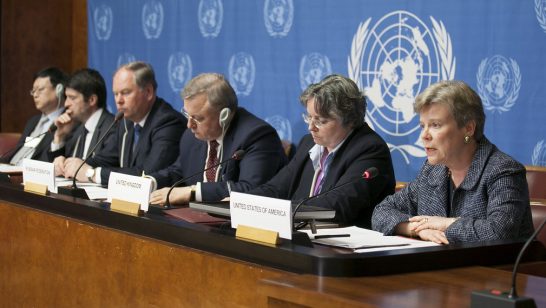
The Nuclear Non-Proliferation Treaty (NPT) will undergo its five-year checkup in New York this year, from 27 April to 22 May. This Review Conference (Revcon) will be unusually important as it will be the 50th anniversary of entry into force of the treaty in 1970, as well as the 25th anniversary of its indefinite extension in 1995. Recent stresses to the treaty regime and early fault lines have emerged which could make this Revcon even more controversial than usual. These involve challenges to the basic premises of the treaty, backsliding on existing nuclear arms control regimes and general lack of progress on urgent problems related to nuclear weapons and international security. In light of these what should we expect from this year’s Revcon?
Setbacks in nuclear arms control
The five years since the last Revcon have not been good for nuclear arms control. Russia’s continued violation of the Intermediate Nuclear Forces (INF) Treaty led to the demise of the treaty in 2019. The New START Treaty is due to expire in February, 2021. If allowed to expire, it will be the first time in half a century that there will be no constraints on the most dangerous weapons of the world’s two largest nuclear states and no agreed regime for understanding what is going on in US and Russian programs in this area. President Putin has expressed his willingness to extend the treaty. President Trump has sent mixed signals regarding his intentions.
The US and Russia are both engaged in massive modernisation of their nuclear weapon programs, including for exotic, unregulated systems. While it is probably not correct to call this a new arms race, it does appear to some as not consistent with the promises and expectations of the NPT.
Rumours have been circulating in Washington that the Trump administration may be considering withdrawing from the Open Skies Treaty and there are voices urging the US to “unsign” the Comprehensive Nuclear Test Ban Treaty (CTBT).
President Trump’s withdrawal from the Joint Comprehensive Plan of Action (JCPOA) with Iran in 2018 created a dangerous situation where the other parties to the agreement have tried hard to maintain its key provisions, and Iran has shown restraint, at least until recently. Heroic EU efforts to find a way around US sanctions have largely failed and Iran has begun to exceed some of the JCPOA limitations, worsening the situation for all.
Although none of these negative developments since 2015 could fairly be blamed on the NPT, all of them can be expected to impact the 2020 Revcon.
The Ban Treaty
The Treaty on the Prohibition of Nuclear Weapons (Ban Treaty) is a major development since the 2015 RevCon. Arising from frustration from the non-nuclear weapon states with the lack of progress by the nuclear weapon states in implementing the commitment in Article VI to eliminate nuclear weapons, it was negotiated very rapidly and opened for signature on September 20, 2017. It comprehensively bans the existence and production of all nuclear weapons, along with their delivery systems. It does not, however, contain any procedures for actually eliminating existing nuclear weapons. It also lacks any definitions or verification regime. Remarkably, it does not require its adherents to join any of the existing major agreements on nuclear weapons, including the NPT itself. Another major difficulty is that it is strongly opposed by all states which actually possess nuclear weapons—in particular, the five nuclear weapon states, otherwise known as the P-5.
The Ban Treaty is likely to be a major topic at the Revcon. Some of the Nuclear-
Weapon States (NWS) view it as undermining the NPT. Supporters of the Ban Treaty have generally insisted that the two are consistent and that, in fact, the Ban Treaty will strengthen and help to implement the NPT. How these arguments play out at the Revcon will be very interesting to watch.
Recent efforts to prepare for the Revcon
As is customary, three Preparatory Conferences have been held. These have been reasonably businesslike with few surprises and most of the problems discussed above have been highlighted. The selection of respected Argentine Ambassador Rafael Mariano Grossi to be President of the Revcon was upended when he moved to the IAEA following the sudden death of Director General Yukiya Amano. The President-designate is fellow Argentine Gustavo Zlauvinen.
A number of initiatives have been taken by groups of countries, as well as by UN Secretary- General Guterrez, during the past five years to advance nuclear arms control. Perhaps the most ambitious is the one known as “Creating an Environment for Nuclear Disarmament” (CEND). Led by the US State Department, it consists of over 40 countries, including all of the P-5. Still in its early stages, it aims to identify those conditions which would have to exist for nuclear weapons to be safely eliminated. Some sceptics have already raised objections to CEND, viewing it as a distraction and a tactic to delay the urgent task of eliminating all nuclear weapons. Another recent effort, involving 16 countries, is the Stockholm Initiative, whose core message is the need to develop “stepping stones,” modest realistic steps toward nuclear disarmament.
The obvious need for effective verification is being addressed by another US initiative—the International Partnership for Nuclear Disarmament Verification (IPNDV). More mature than CEND, involves more than 25 countries and was initiated by the Obama administration. IPNDV is conducting serious work in at least identifying, if not completely solving, the myriad of difficult issues involved in formulating and negotiating the effective verification of nuclear disarmament. One major problem with this effort is that Russia and China are not participating in it.
What to expect from an NPT Revcon
The recent record of Revcons is not encouraging. Generally, the focus (perhaps mistakenly) has been on whether the States-Parties can produce a substantive Final Document. This was achieved in the famous “13 Steps” from the 2000 conference, and the 64 items in the “Action Plan” from the 2010 conference. Given that agreement on such a document must be unanimous among the 191 States-Parties, these were important achievements. However, in both cases, later implementation of these agreed measures was not impressive. In 2005 and 2015, no Final Document was agreed at all. It is probably the case that the quality and subsequent results of the discussions should be considered more important than an overall document itself. Nevertheless, failure to agree on even a summary of what transpired, along with some vision of the path forward, is not a satisfying outcome and, at least in the mind of the general public, reflects poorly on the health of the treaty.
One can see that the US, as well as other countries not part of the Ban Treaty movement, are building a case for the Revcon that they are making good-faith efforts toward fulfilling the promise in Article VI, the NPT’s treaty article which obliges nuclear weapon states to make efforts towards nuclear disarmament. How this will play in the usual NWS-NNWS conflict over Article VI remains to be seen. Another question, given the erratic nature of US foreign policy in the Trump administration, is whether CEND will have a robust life after the Revcon, especially as a US Presidential election looms later in 2020. Another consideration is that, if the Trump administration allows New START to expire with no replacement, it will become extremely difficult to convince other countries that CEND is an enterprise to be taken seriously.
The 2020 Revcon promises to be a dramatic event. Past conferences have frequently descended into arguments between NWS (and their allies) and NNWS. This seems likely to occur again, but with higher stakes this time. Another phenomenon to watch will be P-5 solidarity. This has been reasonably strong in the past, but could be under considerable stress this time as states seek to assign blame for the breakdown in nuclear arms control since the last Revcon. While it would be overly dramatic to claim the future of the NPT hangs in the balance in 2020, a secure future for arms control and nonproliferation is not assured. Nevertheless, recent developments indicate a general desire to avoid damage to the NPT.
The opinions articulated above also do not necessarily reflect the position of the European Leadership Network or any of its members. The ELN’s aim is to encourage debates that will help develop Europe’s capacity to address pressing foreign, defence, and security challenges.
Image: Wikimedia Commons, Patrick Gruben



